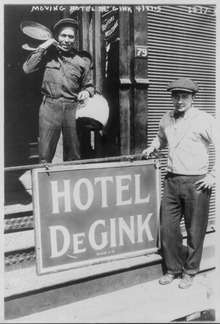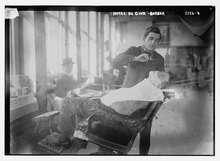Hotel de Gink
Hotel de Gink was a series of self-service hotels created by and for homeless men. Jeff Davis conceived the idea and founded the first Hotel de Gink in Seattle in 1913.[1] The concept quickly spread across the country.

Concept
Although the organization used the name "hotel" and was even a member of the International Hotel Alliance, in practice it was more like a homeless shelter.[2] Hotels De Gink were self-supporting, as residents contributed whatever money they could to support hotel operations.[3] The Hotels provided a range of services, including food, barbering, tailoring, and primitive medical care.[3] All services were provided by residents, who were expected to volunteer at the Hotel for at least two days per week in exchange for lodging.[4] The facilities were self-governing, with a group of residents deciding which applicants to admit.[5]
Residents slept on the floor on donated blankets. Local restaurants donated kitchen supplies and other businesses provided other large pieces of equipment necessary for daily operations. Upkeep and maintenance were provided by residents.[5]
History
The United States experienced a recession starting in 1913.[6] Productions and real income declined during this period and were not offset until the start of World War I increased demand.[7] During this time, there were high periods of unemployment and homelessness.[8] The Hotel de Gink existed to provide relief in these circumstances.[9]
Jeff Davis
Jeff Davis was a vaudeville performer who described himself as "the king of the hobos". He believed in fostering self-sufficiency among the homeless.[10] Combining his interests, he founded a "hobo cabaret" of homeless people with musical talent.[11]
Hotel de Gink
Davis spread the model to other cities.[12] Davis opened branches in Tacoma, Washington and Portland, Oregon. Late in 1914, he approached the New York City government with an offer to open a new facility to accommodate the city's growing homeless population.
The New York City Hotel opened with an over-the-top gala on January 21, 1915. Davis, dubbed "King Jeff" for the night, was seated in a throne adorned with cabbage, carrot, onion and potato, an homage to mulligan stew.[13] The facility was only open during the winter. The New York branch closed shortly before America's entrance into the First World War.[14]
The Buffalo, NY location was opened in 1925 by then Mayor Frank X. Schwab. It closed in 1929 at the end of his term.

Legacy
Although none of the Hotels is still in operation, the legacy survives. The term "Hotel de Gink" became slang for a short term less-than-desirable housing situation[15] and the United States armed forces informally adopted the name Hotel De Gink for transient officer housing.[16][17] Hotel de Gink was also featured in popular culture.[18] In a larger sense, the Hotels proved the concept of self-service homeless services operated and maintained by residents.[1]
References
- Franklin Folsom (1991). America Before Welfare. NYU Press. p. 208. ISBN 978-0-8147-2667-9. Retrieved 1 May 2013.
- "American Hoteliers". Financial Times. April 17, 1926. p. 5.
- The Edison Monthly. 1913. Retrieved 1 May 2013.
- "Hotel De Gink (Seattle)". HistoryLink.org Essay 3849. Retrieved 1 May 2013.
- New York (N.Y.). Mayor's Committee on Unemployment (1916). Report of the Mayor's committee on Unemployment... Press of C.S. Nathan, Inc. p. 4. Retrieved 7 May 2013.
- Joe Martin (19 September 2009). Relentless Change: A Casebook for the Study of Canadian Business History. University of Toronto Press. p. 83. ISBN 978-1-4426-9715-7. Retrieved 7 May 2013.
- Patrick, Buchanan (1999). "A Republic, Not an Empire". New York Times. Retrieved 7 May 2013.
- Glasner, David; Cooley, Thomas F., eds. (1997). Business cycles and depressions: an encyclopedia. New York: Garland Publishing. ISBN 0-8240-0944-4.
- Harvey O'Conner (1 May 2009). Revolution in Seattle. Haymarket Books. p. 7. ISBN 978-1-931859-74-5. Retrieved 7 May 2013.
- JSTOR 1012985
- Ed Lowry (7 February 2011). My Life in Vaudeville: The Autobiography of Ed Lowry. SIU Press. ISBN 978-0-8093-8615-4. Retrieved 7 May 2013.
- "HOTEL DE GINK". Rivet Head. September 22, 2011. Retrieved 1 May 2013.
- "Hotel de Gink Opens in a Blaze of Glory". New York Times. January 22, 1915.
- Michael Carlebach (14 March 2012). Bain's New York: The City in News Pictures 1900-1925. Courier Dover Publications. p. 62. ISBN 978-0-486-47858-6. Retrieved 1 May 2013.
- Julia Emily Johnsen (1921). Selected Articles on Unemployment. H. W. Wilson Company. p. 11. Retrieved 7 May 2013.
- Jonathan Green (2005). Cassell's dictionary of slang. Sterling Publishing Company, Inc. p. 745. ISBN 978-0-304-36636-1. Retrieved 1 May 2013.
- John Algeo (30 July 1993). Fifty Years Among the New Words: A Dictionary of Neologisms 1941-1991. Cambridge University Press. p. 112. ISBN 978-0-521-44971-7. Retrieved 6 May 2013.
- Oliver Mayer (30 January 2008). Collected Plays: Where the Music is. Lulu.com. p. 4. ISBN 978-0-615-18370-1. Retrieved 7 May 2013.